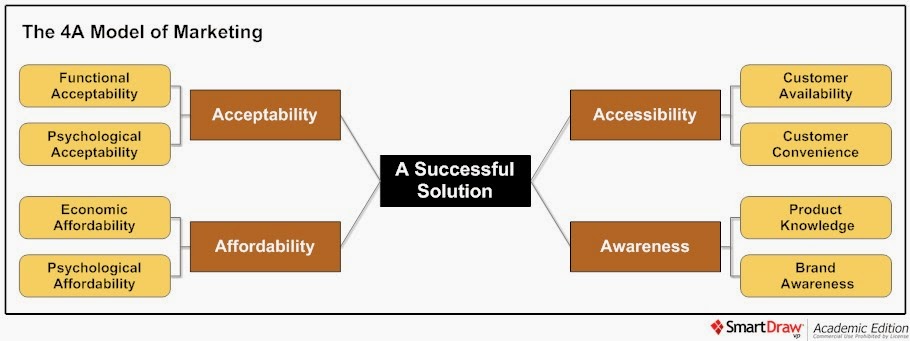One of the most well-known concepts in marketing is the marketing mix, also known as the 4P’s of marketing. The 4P’s model of the marketing mix was introduced in the 1960’s, and it quickly became a bedrock concept of modern marketing.
Despite its popularity and longevity, the 4P’s model has been criticized for a variety of reasons. One frequent criticism is that the 4P’s focus on the selling organization rather than on the customer. This description is factually accurate, but that doesn’t mean the 4P’s model is flawed. It simply means that the 4P’s were never designed to describe what is needed to be successful from the customer’s perspective.
To understand what is required to achieve success with customers, marketers need other tools to complement the 4P’s model. One of these important complementary tools is known as the 4A model of marketing.
The 4A model was developed by Jagdish Sheth, a marketing professor at Emory University, and Dr. Rajendra Sisodia, a marketing professor at Bentley University. Professors Sheth and Sisodia acknowledge that their 4A model was inspired by a similar marketing framework that Coca-Cola used successfully for many years.
The diagram below depicts the structure of the 4A model. As this diagram shows, the major components of the 4A framework are Acceptability, Affordability, Accessibility, and Awareness, and each of these elements has two dimensions. The components of the 4A model are a set of conditions that must be fulfilled to achieve success with any given product or service offering. To use a food analogy, the 4P’s describe the raw ingredients available to the chef, and the 4A’s describe the attributes of meals that will delight a given set of diners.
Components of the 4A Model
Acceptability
The Acceptability component of the 4A model says that a product or service offering must meet or exceed the needs and expectations of customers in a given target market. Acceptability has two dimensions – functional acceptability and psychological acceptability. Functional acceptability refers to the “objective” performance attributes of a product or service. Does the product have the features that customers in the target market expect? Is is reliable? Does it perform as expected?
Psychological acceptability refers to the more “subjective” attributes of a product or service. We often see psychological acceptability associated with so-called “luxury” brands. So for example, a mid-priced automobile may be as objectively functional as a vehicle of comparable size made by Mercedes or BMW. But those brands are more psychologically acceptable to a certain segment of buyers.
Affordability
Affordability refers to whether customers in the target market are economically able and psychologically willing to pay a product’s price. As this definition indicates, affordability also has two dimensions – economic affordability and psychological affordability.
Economic affordability refers to whether the potential customers in the target market have sufficient economic resources to pay a product’s price. Psychological affordability refers to a customer’s willingness to pay, which is primarily determined by a customer’s perception of the value he or she will obtain from a product or service relative to the cost of the product or service.
Accessibility
The third component of the 4A model is Accessibility, which describes whether customers can easily acquire and use a product or service. The two dimensions of Accessibility are availability and convenience.
Availability measures whether a selling company has enough of a product to match customer demand. Convenience refers to how easy it is for potential customers to acquire a product or service. Robert Woodruff, the former chairman of Coca-Cola, captured the essence of Accessibility when he said in 1923 that Coca-Cola should always be “within an arm’s length of desire.”
Awareness
The final component of the 4A model is Awareness, which refers to whether customers are adequately informed about a product’s attributes and benefits in a way that persuades potential buyers to give the product a try and reminds existing users why they should continue to purchase a product. The two dimensions of Awareness are product knowledge and brand awareness. The basic idea here is that most potential customers will not buy unless they have a positive perception of the brand and adequate information regarding the specific product or service.
Like the 4P’s, the 4A model is not a comprehensive model of the marketing function. There are obviously many specific marketing issues that neither the 4P’s nor the 4A’s address. However, the combination of the 4P’s and the 4A’s provides a powerful foundation for shaping marketing strategy.




